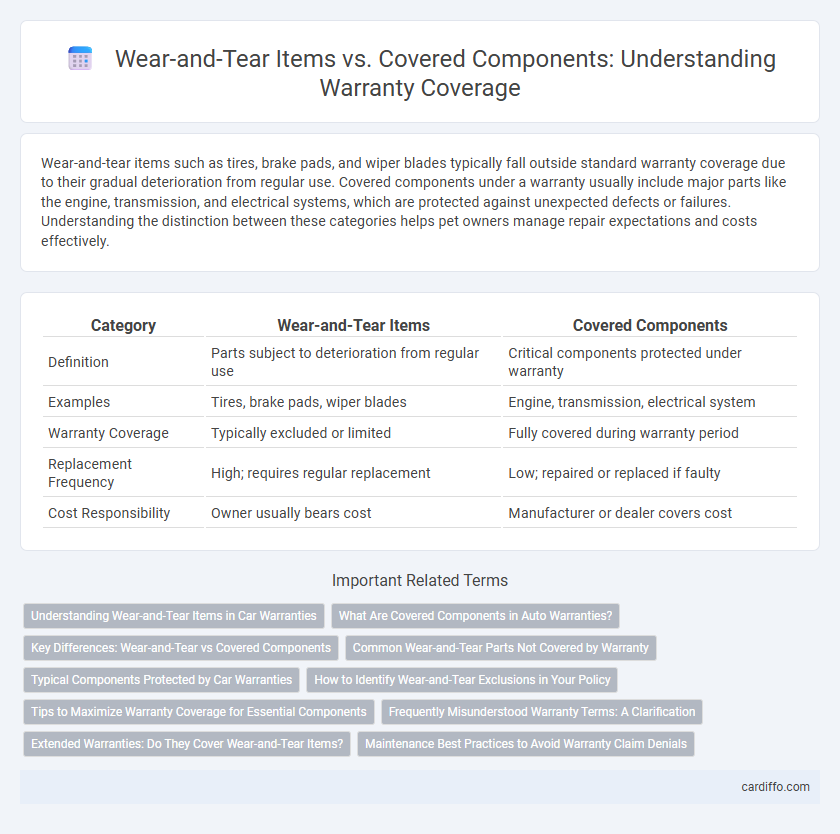Wear-and-tear items such as tires, brake pads, and wiper blades typically fall outside standard warranty coverage due to their gradual deterioration from regular use. Covered components under a warranty usually include major parts like the engine, transmission, and electrical systems, which are protected against unexpected defects or failures. Understanding the distinction between these categories helps pet owners manage repair expectations and costs effectively.
Table of Comparison
| Category | Wear-and-Tear Items | Covered Components |
|---|---|---|
| Definition | Parts subject to deterioration from regular use | Critical components protected under warranty |
| Examples | Tires, brake pads, wiper blades | Engine, transmission, electrical system |
| Warranty Coverage | Typically excluded or limited | Fully covered during warranty period |
| Replacement Frequency | High; requires regular replacement | Low; repaired or replaced if faulty |
| Cost Responsibility | Owner usually bears cost | Manufacturer or dealer covers cost |
Understanding Wear-and-Tear Items in Car Warranties
Wear-and-tear items in car warranties typically include parts such as brake pads, tires, and wiper blades that naturally degrade through regular use. These components are often excluded from standard warranty coverage because their deterioration is expected over time rather than resulting from manufacturing defects. Understanding the distinction helps vehicle owners know which repairs or replacements they may need to fund out-of-pocket versus those covered under warranty terms.
What Are Covered Components in Auto Warranties?
Covered components in auto warranties typically include essential parts such as the engine, transmission, drivetrain, and electrical systems, which are protected against defects in materials or workmanship. These components are distinguished from wear-and-tear items, which naturally deteriorate over time through regular use and are often excluded from coverage. Understanding the specific parts classified as covered components helps vehicle owners know what repairs and replacements their warranty will support.
Key Differences: Wear-and-Tear vs Covered Components
Wear-and-tear items are parts expected to degrade with regular use, such as brake pads, tires, and wiper blades, and typically fall outside standard warranty coverage. Covered components include critical mechanical and electrical parts like the engine, transmission, and battery, which are protected under most manufacturer warranties against defects and failures. Understanding these key differences helps consumers know which repairs are warranty-covered versus those requiring out-of-pocket expenses.
Common Wear-and-Tear Parts Not Covered by Warranty
Common wear-and-tear parts such as brake pads, tires, windshield wipers, and battery cells are typically excluded from standard vehicle warranties due to their expected degradation over time. Manufacturers classify these components separately from covered components like the engine, transmission, and electrical systems, which receive warranty protection against defects and malfunctions. Understanding the distinction helps consumers manage maintenance costs and avoid unexpected expenses outside the warranty coverage.
Typical Components Protected by Car Warranties
Typical components protected by car warranties include the engine, transmission, and drivetrain, which are essential for vehicle operation and often covered under powertrain warranties. Wear-and-tear items such as brake pads, tires, and windshield wipers are generally excluded because they require regular replacement due to normal use. Coverage specifics vary by manufacturer, with comprehensive warranties often extending to electronic systems, air conditioning, and suspension components.
How to Identify Wear-and-Tear Exclusions in Your Policy
Wear-and-tear exclusions in your warranty policy are typically identified by carefully reviewing the list of covered components versus consumable parts subject to regular use and deterioration. Common wear-and-tear items often include brake pads, tires, and filters, which are explicitly excluded due to their expected maintenance cycle. Verifying the warranty's fine print or service manual helps distinguish between permanent components covered under the warranty and those excluded because of standard usage degradation.
Tips to Maximize Warranty Coverage for Essential Components
To maximize warranty coverage for essential components, regularly maintain wear-and-tear items such as belts, filters, and tires to prevent premature failure that could void the warranty. Keep detailed service records and adhere strictly to the manufacturer's recommended maintenance schedule for covered components like the engine, transmission, and electrical systems. Promptly address minor issues before they escalate, ensuring all repairs are performed by authorized service centers to maintain full warranty eligibility.
Frequently Misunderstood Warranty Terms: A Clarification
Wear-and-tear items such as brake pads, tires, and wiper blades are typically excluded from warranty coverage due to their expected degradation through regular use, while covered components include critical parts like the engine, transmission, and electrical systems protected under most vehicle warranties. Misunderstanding these distinctions often leads consumers to assume all parts of their vehicle are covered, resulting in unexpected out-of-pocket expenses. Clarifying these terms ensures customers know which repairs are included, helping manage expectations and avoid confusion during warranty claims.
Extended Warranties: Do They Cover Wear-and-Tear Items?
Extended warranties typically do not cover wear-and-tear items such as brake pads, tires, or filters, focusing instead on major components like the engine, transmission, and electrical systems. Understanding the distinction between wear-and-tear items and covered components is essential for consumers to avoid unexpected repair costs. It is crucial to review the extended warranty terms carefully to confirm which parts are included and which are excluded from coverage.
Maintenance Best Practices to Avoid Warranty Claim Denials
Regular maintenance of wear-and-tear items such as brake pads, tires, and filters is crucial to prevent premature failure and avoid warranty claim denials. Manufacturers typically exclude these components from warranty coverage because they naturally degrade over time due to usage and environmental factors. Adhering to recommended service intervals and using approved parts can ensure covered components remain protected, preserving warranty validity.
Wear-and-Tear Items vs Covered Components Infographic

 cardiffo.com
cardiffo.com